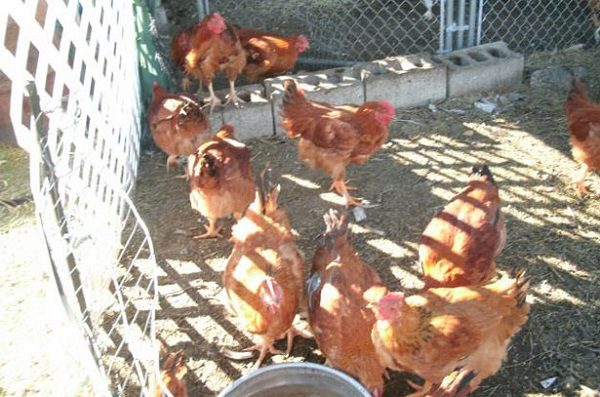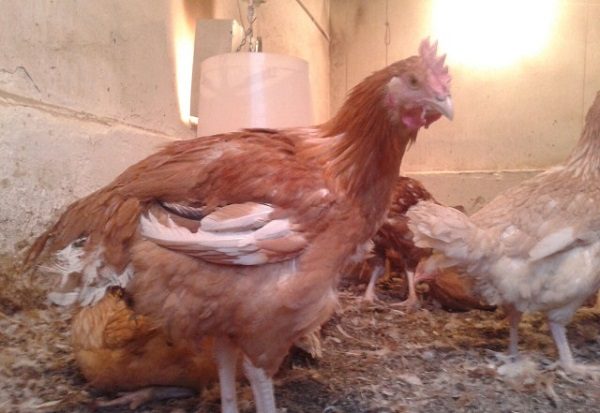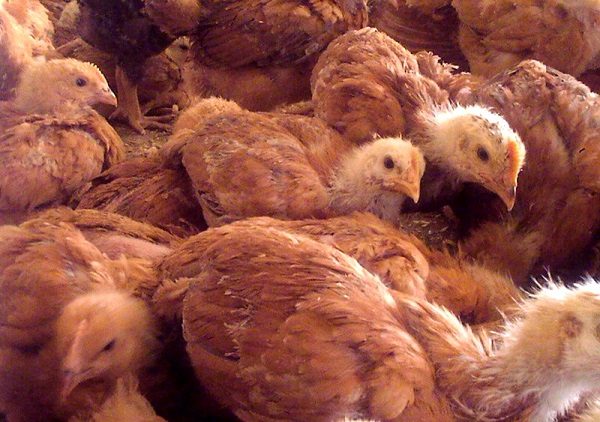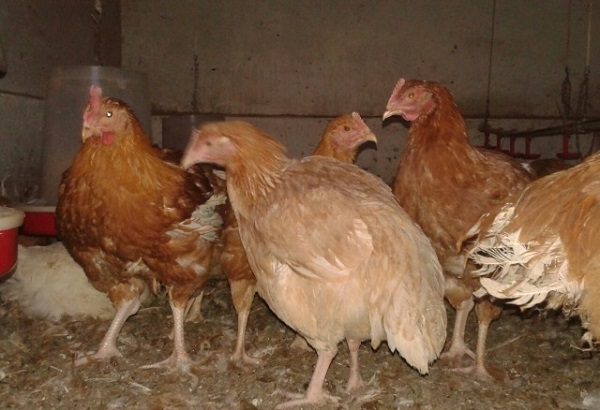A special place for breeding chickens is growing hybrids. Redbro chickens, which first appeared in poultry farms more than a century ago and were bred by crossing Cornish birds with Malay fighting cocks, belong to hybrids.
Redbro is home to the UK, but they are most popular among poultry farmers in France and the United States. In this article we will look at the characteristics of chickens redbro. Let's talk about the description of chickens redbro, as well as learn the secrets of their rearing.
Table of contents
Chickens redbro: breed description
It will be extremely difficult for a newcomer in the poultry business to distinguish redbro chickens from ordinary domestic hens, which is largely due to the unassuming external features of the breed.
Appearance
Redbro - a large breed of birds. The head of the chicken is large, the plumage is dense. In laying hens there is a short, clearly defined beak and a bright red comb. The shape of the ridge is leaf-shaped or pod-like. The earlobes are bright, so they are not difficult to notice.
The color of feathers is red, sometimes turning into red-brown. In rare cases, birds with white plumage, but this color of feathers is considered the exception rather than the rule.
Temperament
Redbro chickens are extremely livable, endowed with a calm and peaceful nature, which is why they are easy to keep with other birds. When breeding this breed, it is better not to use the cages, Redbro is extremely freedom-loving, therefore a spacious hen house with a free exit to the range is more suitable for their maintenance.
The minimum temperature in the chicken coop should not fall below 7 degrees and rise above 25. Otherwise, chickens are more than unpretentious, it is much easier to keep them than other breeds, including broilers.
Industrial farms or homestead
Redbro - chickens are universal, birds feel at ease on the usual backyard plot as well as on the large poultry farm. They are bred most often for a large number of eggs. However, this breed belongs to the egg and meat, and is in great demand precisely for these qualities.
In Europe and America, chickens are raised on a large scale., while the purity of the breed is monitored by veterinarians, which is practically impossible in the backyard conditions.

Characteristic
Weight of hens and roosters
Breeding chickens redbro is quite a profitable business. The weight of adult chickens reaches 3 kilograms, roosters - 4.5 kilograms, and this weight of the bird reaches as early as 4-5 months of feeding on normal feed.
Egg production
On average, one adult chicken is able to carry up to 160 eggs per year. But some layers can have different egg-bearing qualities, allowing you to collect up to 250-300 eggs per year.
A lot of eggs
Eggs of redbrow chickens are medium in size, the color of eggs is white or light beige. The weight of the egg is at least 60-70 grams.
Feed intake per day
To saturate one bird, at the age of:
- from 2 weeks you need at least 100-150 grams of feed per day;
- a three-week chicken consumes around 180-200 grams of feed;
- monthly chicken consumes at least 200-220 grams per day;
- chickens between the ages of 5-6 weeks need on average up to 230-240 grams of feed;
- chicken from 7 to 8 weeks should eat at least 245-250 grams of feed;
- six-month-old chicken should be fed 300-350 grams of feed per day.
How much feed is on one egg?
To get 1 egg, the chicken must eat at least 50 grams of grain,30 grams of wet mash, 100 grams of boiled potatoes, 10 grams of oil cakes, 10 grams of hay flour, 100 grams of milk, a few pinches of chalk and salt. The presence of a permanent source of clean water is required.

Red Broiler Species
In Russia, it is usually not to meet the division of chickens with redbro species, but European poultry farmers are well aware of the conditional division of birds into redbro M and redbro C category. The cultivation of those and others are engaged in the company Hubbard - the largest poultry farms in France to raise birds of this particular breed.
Get a variety of chickens redbro M when crossing layers of redbro M with redbrow roosters. Similarly, it is possible to get redbro S. chicks.
Breeding
Daily redbrow chicks should have constant access to fresh milk, curd and finely chopped greens. Obligatory element of the diet should be boiled and crushed with a grater, an egg. Older chickens are allowed to give wet and dry mash.
Adult redbro chickens enjoy eating chopped vegetables and fruits. If fruit trees grow on the plot, chickens can feed on overripe and falling fruits. In addition, it is necessary to ensure the access of birds to small pebbles, chalk, ash, or seashells.
To make the eggshell stronger, you should add potatoes, oil cakes, silage, pine flour and even milk to your normal layer ration.

Special features
They contain birds in an ordinary house, placing in it the necessary number of perches, feeders and drinkers. A mandatory attribute of the house should be a container of ash and sand, necessary for chickens to take dry baths that protect against the occurrence of parasites.
Birds are extremely clean, because cleaning the house should be done at least 1 time a week, removing the top layer of straw bedding, which must be laid on the floor, and imposing a new one.
Despite the fact that the birds of this cross country are considered resistant to various diseases, it is better to vaccinate the entire livestock well in advance, as well as to disinfect the room where the chickens will be most of the time.
For disinfection, it is best to use a 2% caustic soda solution, 3% formalin solution, or 3-5% p-creolin solution.
The ceilings and walls of the coop must be lime-washed and left to air for at least a day. Only after that you can settle there chickens.
Diseases and treatment
In comparison with broilers, on which this cross looks very similar in external and meat qualities, the latter have a number of invaluable advantages. The most significant of these is resistance to various chicken diseases, such as:
- Typhus Infectious disease, the symptoms of which are manifested mainly from the digestive tract. The chicken starts to get sick, and diarrhea is possible. There is a lack of appetite, fever, weakness. The disease is transmitted by airborne droplets, healthy day-old chicks can become infected by eating eggs. They treat the disease with antibiotics.
- Coccidiosis The cause of the disease is a parasite. The disease is transmitted by direct contact. Signs of it are diarrhea, apathy, fever, depression.The main drug is furagin, zolen and coccidin. The medicine is added to the water and food of sick and healthy birds. Most often, the disease affects the young.
- Pasteurellosis. The first sign of the disease is blueing of the earrings and chicken scallop. The bird becomes sluggish, there is diarrhea, the discharge of mucus from the nose, temperature, the appearance of swelling in the legs. The disease is treated with sulfamide preparations, simultaneously producing large-scale disinfection of the chicken coop.
- Salmonellosis. Inadequate vaccination may lead to infection of birds with salmonellosis. Signs of illness are weakness, apathy, loss of appetite, diarrhea, cessation of growth of young animals, swelling around the eyes. The disease is treated with furazolidone by adding the medicine to the drinking water. The course of treatment is 10 days, at the same time it is recommended to isolate infected birds from healthy ones.
These diseases are common to all breeds of birds in general, but the redbrow chickens are sick less often than others, which the creators of the cross have taken care of.

The advantages and disadvantages of the breed
The main advantages of redbuss cross are:
- high survival rate of young stock;
- dietary meat;
- a large number of eggs;
- tendency to fattening;
- ability to gain weight quickly;
- outwardly attractive bird species.
The lack of the breed is its similarity with the usual Russian domestic hens, which is often used by dishonest sellers.
Breed Reviews
Evgenia Viktorovna: Normal broiler red color. I liked the taste of meat, as well as its quantity. As hens of hen redbro are not bad, they were satisfied, despite some loss of the basic qualities of their parents.
Lydia: Chickens acquired 3 years ago at one of the agricultural exhibitions in Yaroslavl. No negative qualities are not noticed. The only thing that is necessary to carefully monitor the purity of the chicken coop, the redbro practically does not get sick, which makes me very happy.
Valentine:High quality cross, I have never had to work with such a bird before. The meat is just amazing, despite the small streaks. The taste qualities of eggs are not described at all. I keep chickens in an ordinary bird, their character is peaceful, I didn’t notice any problems with livability, therefore I recommend it to all poultry breeders.
Conclusion
Chickens redbro - English cross, bred for the sake of obtaining a large amount of dietary meat in the shortest possible time. Meat and egg qualities of cross-country are appreciated in many countries of the world. From one chicken it is possible to get 160 eggs a year.

Until now, I did not think about the fact that chickens hybrids are also taken out. Interestingly, the taste of eggs of this chicken is different from what we used to buy in stores? And the meat? I would like to know the opinion of ordinary consumers.
Olga tastes eggs in general is no different. Eggs are more likely to be affected by food, rather than by breed of chickens.